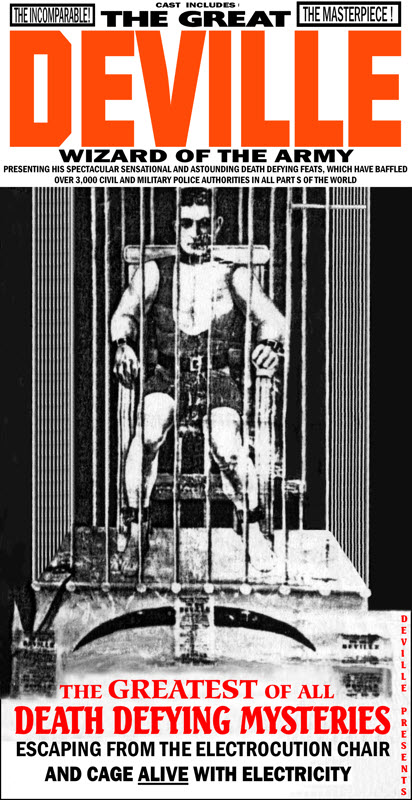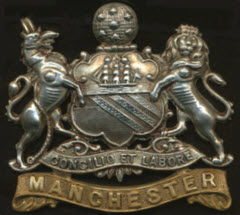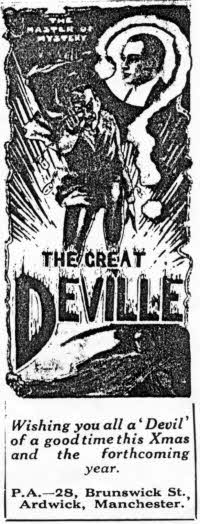 was born on December 2nd 1885 at Brierley Hill, Birmingham, into an age of great magicians. His performing career overlapped those of John Nevil Maskelyne (1839-1917), David Wighton (1868-1941), who performed as David Devant, Sigmund Neuberger (1871-1911), who was the celebrated illusionist The Great Lafayette, William Elsworth Robinson (1861-1918), who died on stage performing his bullet-catching illusion as Chung Ling Soo, the 'Marvellous Chinese Conjurer' and Erich Weiss (1874-1926), who became world famous as Harry Houdini. was born on December 2nd 1885 at Brierley Hill, Birmingham, into an age of great magicians. His performing career overlapped those of John Nevil Maskelyne (1839-1917), David Wighton (1868-1941), who performed as David Devant, Sigmund Neuberger (1871-1911), who was the celebrated illusionist The Great Lafayette, William Elsworth Robinson (1861-1918), who died on stage performing his bullet-catching illusion as Chung Ling Soo, the 'Marvellous Chinese Conjurer' and Erich Weiss (1874-1926), who became world famous as Harry Houdini.
 |
The future performer became Barton Turner at the age of 3, when his mother, a widow with three young sons, remarried. Barton Turner had a compact build and he was something of an athlete in his younger days, winning prizes for distance races – both attributes serving him well in his career as an escapologist.
The postcard with the picture that became his trade mark [left & featured on the Front Page] shows him in 1908 in a typical escapologist's pose in the early part of a career that was interrupted twice by world wars. A picture of Harry Houdini, taken during his tour of England during the summer of 1909, is shown below Barton's concept for comparison purposes.
It was natural for a developing escapologist to take Harry Houdini as his role model and when Houdini and his brother Hardeen were topping bills Europe, Barton Turner is reported to have adopted the name of Leo Houdeen briefly. He soon switched to the more original, and exotic, Henri Deville.
Barton Turner married Lucy Alice Parker (1895-1975) on March 10th 1915 at St. Paul's church in Manchester. Lucy was one of six sisters; she also had two brothers. The marriage produced two children: Harry (1920-2009) and Dorothy, who died at the young age of 14 early in 1936.
 Deville registered for military service in the Great War in December 1915. He was called up in June 1916 and appointed to 25th Battalion of the Manchester Regiment as a reservist. Private 24683 received a number of postings to reserve battalions on the home front, he was appointed an acting corporal (unpaid) in May of 1917 and "promoted" to acting sergeant (unpaid) in December 1917; presumably on the basis of his skills as an organizer, which served him well when running a magic-based touring company after the war. Deville registered for military service in the Great War in December 1915. He was called up in June 1916 and appointed to 25th Battalion of the Manchester Regiment as a reservist. Private 24683 received a number of postings to reserve battalions on the home front, he was appointed an acting corporal (unpaid) in May of 1917 and "promoted" to acting sergeant (unpaid) in December 1917; presumably on the basis of his skills as an organizer, which served him well when running a magic-based touring company after the war.
He was demobilized in April of 1919 and he billed himself as the Wizard Of The Army when performing in the music halls in the 1920s and 1930s.
His act included both escapology and illusions and his stage name is assumed to be a variation of the Wizard of the Navy tag used by Valentine Walker, also from the Birmingham area, who served in the Royal Navy and performed escapes and illusions in the music halls until 1924.
Going into the theatrical trade seems to have been a family tradition for the Turner family; Deville's brother, Percy Turner (1884-1971), created a career for himself as a theatrical producer.
 The trunk escape described in the Magic Wand review above seems rather tame compared to his escape from the Electrocution Chair in the Cage ALIVE With Electricity [see poster] and his escapes from a set of manacles similar to those shown on the Deville postcard whilst sealed in a tank full of water. The trunk escape described in the Magic Wand review above seems rather tame compared to his escape from the Electrocution Chair in the Cage ALIVE With Electricity [see poster] and his escapes from a set of manacles similar to those shown on the Deville postcard whilst sealed in a tank full of water.
His stage illusions involved feats such as chopping his sister-in-law, Pat Parker, alias Mdlle. Victoire, into a dozen pieces in the presence of an on-stage committee of members of the audience.
Deville's jobs when not touring included working as an insurance agent. He sold equipment for escapes and illusions from the middle 1930s on. During the Second World War, he built aircraft for the Fairey Company in the Manchester area, but he returned to performing after the war, working at the now defunct Belle View Amusement Park in Manchester until the late 1950s. His act as an illusionist during this period included his Human Wireless Illusion.
During this period, the amusement park was run by the father of one of grandson Philip Turner's classmates, which meant that he could visit his grandfather on the way home from school in Manchester 'for free'.
Retinal detachments after cataract operations brought his performing career to a close, but Deville continued to sell handcuffs, chain sets, electrical illusions, books on magic and instructions for illusions until well into the 1960s. The Great Deville died at his home in Romiley in December 1970, four days after his eighty-fifth birthday.
 A biographical article about the Great Deville written by Dr. Edwin Dawes, a Member of the Inner Magic Circle, appeared in his monthly column in the Circle's journal, A Rich Cabinet of Magical Curiosities, in June 1987. [Magic Circular, 81, 113-116]. Article No. 134, THE GREAT DEVILLE, WIZARD OF THE ARMY, is based on research by Dr. Dawes and includes contributions from the Turner family, which helped to clear up questions raised in 1981 about the "electrocution chair" escape as performed by someone who was not included in then contemporary books on magic. A biographical article about the Great Deville written by Dr. Edwin Dawes, a Member of the Inner Magic Circle, appeared in his monthly column in the Circle's journal, A Rich Cabinet of Magical Curiosities, in June 1987. [Magic Circular, 81, 113-116]. Article No. 134, THE GREAT DEVILLE, WIZARD OF THE ARMY, is based on research by Dr. Dawes and includes contributions from the Turner family, which helped to clear up questions raised in 1981 about the "electrocution chair" escape as performed by someone who was not included in then contemporary books on magic.
 The article also appears in The Complete Rich Cabinet of Magical Curiosities (2005), an ebook containing the first 200 columns by Dr. Dawes. The article also appears in The Complete Rich Cabinet of Magical Curiosities (2005), an ebook containing the first 200 columns by Dr. Dawes.
 A feature on the Great Deville based on this website was created by Charles Legge of the Daily Mail for his Answers to Correspondents column in response to a correspondent asking "Which magician was famous for cutting his assistant into 12 parts?" A feature on the Great Deville based on this website was created by Charles Legge of the Daily Mail for his Answers to Correspondents column in response to a correspondent asking "Which magician was famous for cutting his assistant into 12 parts?"
 The item appeared in the issue for Wednesday 17th February, 2021. The item appeared in the issue for Wednesday 17th February, 2021.
|






 was born on December 2nd 1885 at Brierley Hill, Birmingham, into an age of great magicians. His performing career overlapped those of John Nevil Maskelyne (1839-1917), David Wighton (1868-1941), who performed as David Devant, Sigmund Neuberger (1871-1911), who was the celebrated illusionist The Great Lafayette, William Elsworth Robinson (1861-1918), who died on stage performing his bullet-catching illusion as Chung Ling Soo, the 'Marvellous Chinese Conjurer' and Erich Weiss (1874-1926), who became world famous as Harry Houdini.
was born on December 2nd 1885 at Brierley Hill, Birmingham, into an age of great magicians. His performing career overlapped those of John Nevil Maskelyne (1839-1917), David Wighton (1868-1941), who performed as David Devant, Sigmund Neuberger (1871-1911), who was the celebrated illusionist The Great Lafayette, William Elsworth Robinson (1861-1918), who died on stage performing his bullet-catching illusion as Chung Ling Soo, the 'Marvellous Chinese Conjurer' and Erich Weiss (1874-1926), who became world famous as Harry Houdini.

 Deville registered for military service in the Great War in December 1915. He was called up in June 1916 and appointed to 25th Battalion of the Manchester Regiment as a reservist. Private 24683 received a number of postings to reserve battalions on the home front, he was appointed an acting corporal (unpaid) in May of 1917 and "promoted" to acting sergeant (unpaid) in December 1917; presumably on the basis of his skills as an organizer, which served him well when running a magic-based touring company after the war.
Deville registered for military service in the Great War in December 1915. He was called up in June 1916 and appointed to 25th Battalion of the Manchester Regiment as a reservist. Private 24683 received a number of postings to reserve battalions on the home front, he was appointed an acting corporal (unpaid) in May of 1917 and "promoted" to acting sergeant (unpaid) in December 1917; presumably on the basis of his skills as an organizer, which served him well when running a magic-based touring company after the war.
 The trunk escape described in the
The trunk escape described in the  A biographical article about the Great Deville written by Dr. Edwin Dawes, a Member of the Inner Magic Circle, appeared in his monthly column in the Circle's journal, A Rich Cabinet of Magical Curiosities, in June 1987. [Magic Circular, 81, 113-116]. Article No. 134, THE GREAT DEVILLE, WIZARD OF THE ARMY, is based on research by Dr. Dawes and includes contributions from the Turner family, which helped to clear up questions raised in 1981 about the "electrocution chair" escape as performed by someone who was not included in then contemporary books on magic.
A biographical article about the Great Deville written by Dr. Edwin Dawes, a Member of the Inner Magic Circle, appeared in his monthly column in the Circle's journal, A Rich Cabinet of Magical Curiosities, in June 1987. [Magic Circular, 81, 113-116]. Article No. 134, THE GREAT DEVILLE, WIZARD OF THE ARMY, is based on research by Dr. Dawes and includes contributions from the Turner family, which helped to clear up questions raised in 1981 about the "electrocution chair" escape as performed by someone who was not included in then contemporary books on magic.